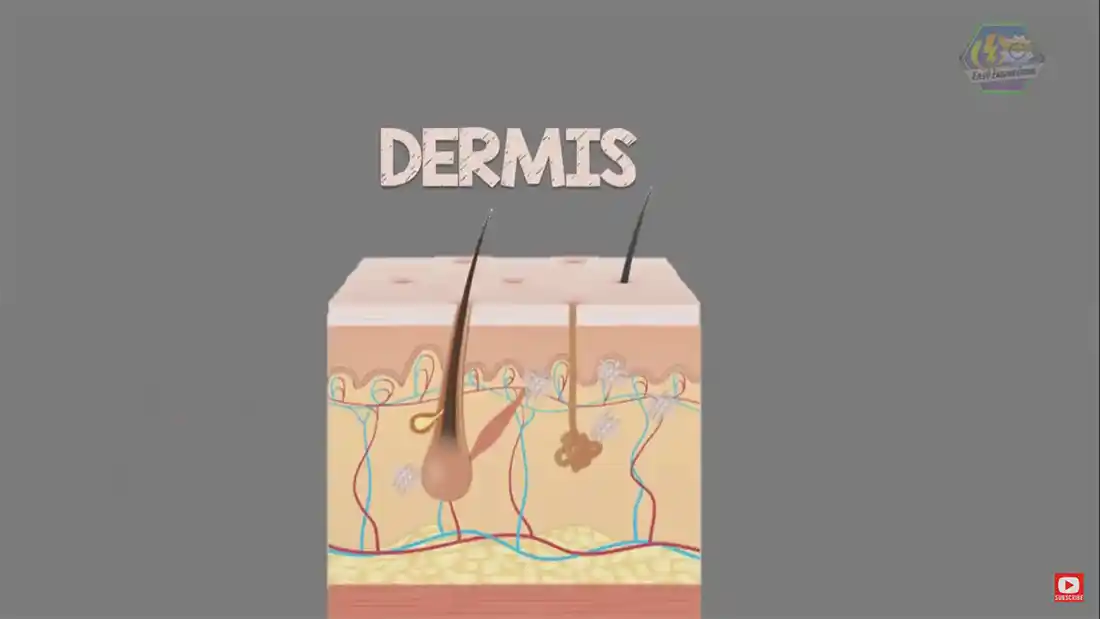

Integumentary system, skin, nails, hair, exocrine gland, protection, infection, sweat, perspiration, displacement of dirt.
As humans, we are prone to infection and disease. There are ways we can combat this, through medication. But there is also a natural way our body deals with some of this as well.
The integumentary system protects us from the majority of this, but sometimes it's not enough for us to steer clear of infection.
The integumentary system is mostly external, and helps with the movement of infectious bacteria and molecules away from orifices where they can enter.
Within this system, it includes:
The following still is from a video on the integumentary system, with the following details:
Please click on the image to view the video.


Our skin is the largest organ in the human body. We often don't think of it as an organ, but it acts in similar ways to other organs, and protects all the bits inside the body from dirt ingress and foreign bodies.
So, with all this in mind, what do they do?
First, the skin covers our whole body. It has several layers, which serve to protect our internal organs and other components from infection. If we cut ourselves, the body works tirelessly to repair the damage, and also to limit the amount of foreign bodies that enter. Our skin shares similarities with plants, in that the top layer is called the epidermis.
Being the largest organ on the body (not in, although you could argue this fact), our skin requires a lot of work. We need to maintain it in order to keep it supple, easy to bend and to help keep it healthy. You need to eat the right types of food for vitamins and nutrients needed for it to work effectively, as well as to stop the dryness some people have with their skin.
There are conditions that cannot be helped (such as eczema) that means your skin is always dry in places, but again, these can be maintained by using the right creams or ointments to keep them healthy too.
We all have hair. It's everywhere. Some people have a lot more than others. It plays a major part with the integumentary system. Depending where it is situated, the displacement of dirt is handled by the hair. Hair also helps in regulating temperature, keeping us warm in the winter, and keeping us cool in the summer.
It does this by holiding the heat in and close to our body (winter), or moving it away (summer). We have areas on your body that keep the heat in (generally out genitalia, as well as under the arms in our armpits), and these keep the heat in. This is done by the hair that is placed there as well.
Why do we have nails? And where are they? Our nails form part of our fingers and toes. They grow at a steady rate, and there are several parts to them, including:
The nail helps to protect our fingers and toes from any injury or trauma. How many times have you caught your finger in a draw? And how many times has it not been as bad due to the fact that your nail is there?
The nail also helps with our sense of touch. They help because we can feel through the nail. When you let your nails grow, they can scratch the surface - your skin, a worktop counter, the bark of a tree, and so on.
There are four types of exocrine glands - glands that secrete a substance outside the body - that work with the integumentary system. They include:
Sudoriferous glands: these are the sweat glands. They are hollow cylindrical structures under the skin, and excrete sweat by small openings in the surface of the skin. This helps to cool off the body when it gets too hot.
Sebacious glands: located in the dermis, a layer of the skin, these are small tubular-shaped glands, responsible for releasing oils in the hair follicle. This then helps protect the hair shaft, and stops the hair becoming hard and brittle. Sometimes, some people produce quite a bit of this, hence the term greasy hair. It can be treated with shampoo that works on greasy types of hair.
Ceruminous glands: these are where ear wax is created, and they are located in the ear canal. It keeps foreign invaders like bacteria and fungus from entering the ear and also protects from any physical damage.
Mammary glands: these are glands that produce milk (in a woman) for babies to drink after pregnancy. They are semi-circular in shape, and both men and women have them. They are located at the front of the chest. A single mammary gland can weigh up to 1kg (2.2 pounds).
Along with all these components working together, the system works in tandem with other systems, to help regulate things like body temperature (in the thermoregulatory centre), metabolism and sensory nerves to provide the sense of touch. It literally works with every other system in the body to help maintain it and keep it as healthy as it can be so we don't get infected.
If you are unable to see the board, please click here.
Disclaimer | About Me | Sitemap
Website design by SyntaxHTML.



Blue icons adapted from icons courtesy of Smashicons.com